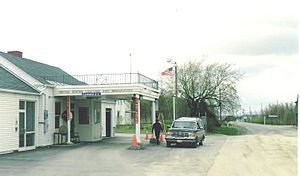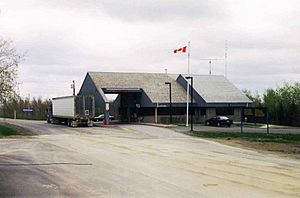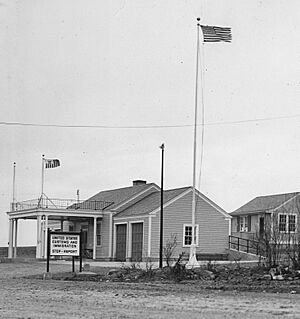Limestone–Gillespie Portage Border Crossing facts for kids
Quick facts for kids Limestone–Gillespie Portage Border Crossing |
|
|---|---|

US Border Inspection Station in Limestone, Maine as seen in 1998
|
|
| Location | |
| Country | United States; Canada |
| Location |
|
| Coordinates | 46°55′29″N 67°47′22″W / 46.924667°N 67.789571°W |
| Details | |
| Opened | 1929 |
| US Phone | (207) 325-4769 |
| Canadian Phone | (506) 473-3536 |
| Hours | Open 6:00 AM-10:00 PM Eastern |
|
U.S. Inspection Station-Limestone, Maine
|
|
| MPS | U.S. Border Inspection Stations MPS |
| NRHP reference No. | 14000556 |
| Added to NRHP | September 10, 2014 |
The Limestone–Gillespie Portage Border Crossing is a special place where the United States and Canada meet! It connects the town of Limestone, Maine in the US with Grand-Sault, New Brunswick in Canada. This crossing is used by people traveling between the two countries.
You can reach the crossing using Maine State Route 229 on the American side. On the Canadian side, you would use New Brunswick Route 375. The buildings on the US side are very old. They are the original ones built in 1933. These buildings are so important that they were added to the National Register of Historic Places in 2014. This means they are protected because of their history.
Just a short distance south of the border crossing, there's an old Nike missile base. This was once a military site with missiles to protect nearby Loring Air Force Base. Today, it's no longer used for missiles and has become an auto repair shop.
Crossing the Border: Canadian Side
The Canadian government built its first border station here around 1930. This is where travelers would stop to show their passports and declare items. The current building on the Canadian side was built later, in 1984. It helps border agents check people and goods entering Canada.
Crossing the Border: United States Side
The US border station originally had a main building and two houses behind it. The houses were later taken down. The main building is made of wood and has one story. It has special garage areas where cars can be inspected. This building is very close to the actual border line.
Inside the building, there were separate areas. One side was for customs, handled by the USCS. They checked goods and items people brought into the country. The other side was for immigration, handled by the INS. They checked people's documents and identities.
Before these special border stations were built, you would have to go to the nearest town to complete these checks. But in the 1920s, more and more people started driving cars. Also, the government wanted to stop illegal alcohol from coming into the country during a time called Prohibition. Prohibition was a period when making, selling, and transporting alcohol was against the law.
Because of these reasons, the government decided to build many border stations right at the border. This made it easier to check cars and people. The Limestone station was approved in 1931. The government bought the land in 1932, and construction started in 1933. The station officially opened in January 1934.
Even though there were standard designs for these stations, the Limestone building is unique. It doesn't follow any of the usual plans. It's similar to a "Type 2" station but was built using less expensive materials. The station is important for its design and its role in helping the US government control its borders.



